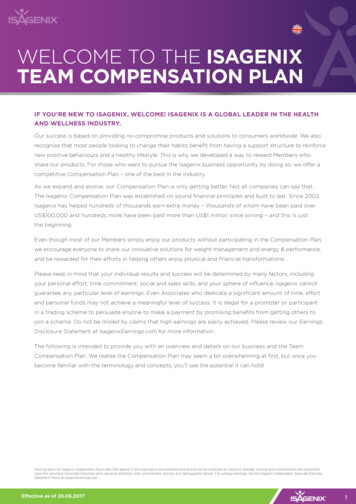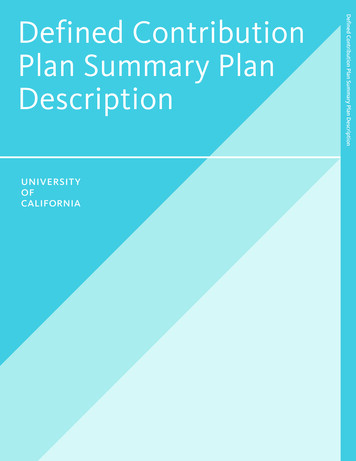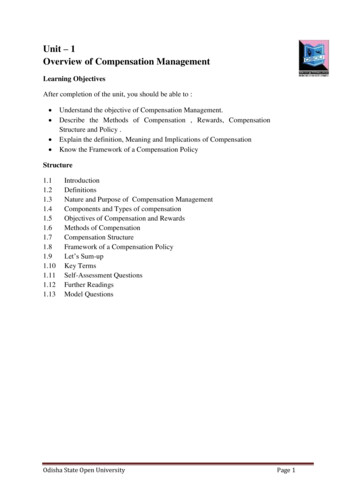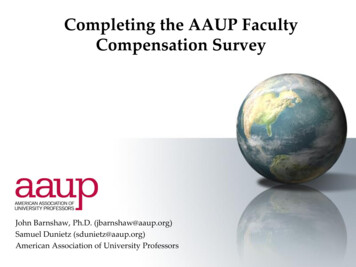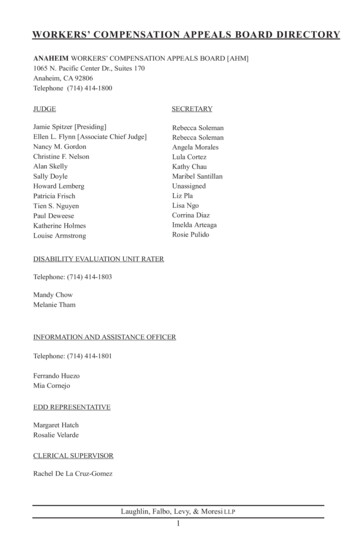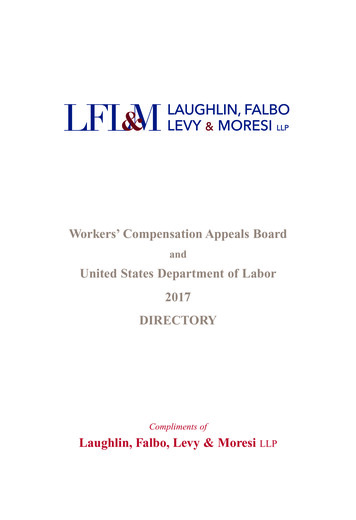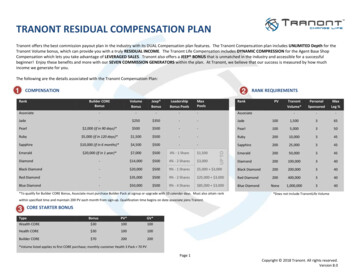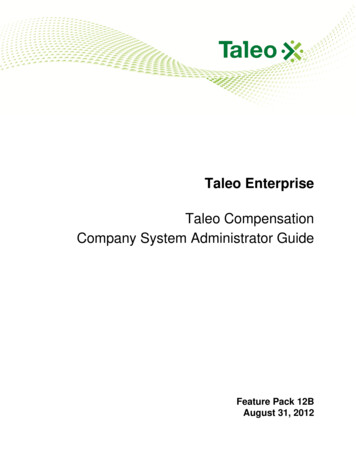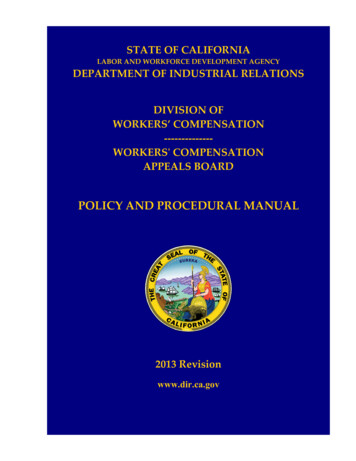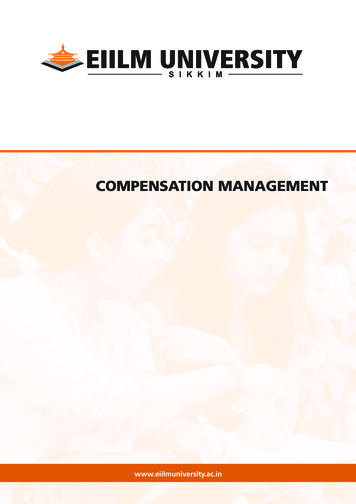
Transcription
COMPENSATION MANAGEMENTwww.eiilmuniversity.ac.in
Subject: COMPENSATION MANAGEMENTCredit: 4SYLLABUSObjectives of CompensationIntroduction to Compensation and Rewards; Objective of Compensation and Rewards; Introduction toFramework of Compensation Policy; Labor market characteristics and pay relativesWage Determination:Introduction to Compensation, Rewards, Wage Levels and Wage Structures; Introduction to WageDetermination Process and Wage Administration rules; Introduction to Factors Influencing Wage and SalaryStructure and Principles of Wage and Salaries Administration; Introduction to the Theory of Wages:Introduction to Minimum, Fair and Living WageWage DeferentialIntroduction to Minimum Wages; Introduction to Basic Kinds of Wage Plans; Introduction to WageDifferentials & Elements of a Good Wage Plans; Introduction to Institutional Mechanisms for WageDeterminationExecutive CompensationLegalistic Framework for Wage Determination; Introduction to Importance of Wage Differentials; Introductionto Executive Compensation and Components of RemunerationJob EvaluationIntroduction to Nature and Objectives of Job Evaluation; Introduction to Principles and Procedure of JobEvaluation Programs; Introduction to Basic Job Evaluation Methods; Introduction to Implementation ofEvaluated Job; Introduction to Determinants of Incentives; Introduction to Classification of Rewards; IncentivePayments and its Objectives.Wage IncentivesIntroduction to Wage Incentives in India; Introduction to Types of Wage Incentive Plans; Introduction toPrevalent Systems & Guidelines for Effectives Incentive Plans; Introduction to Non- Monetary IncentivesProfit SharingIntroduction to Cafeteria Style of Compensation; Introduction to Problems of Equity and Bonus; Profit Sharing& Stock Options; Introduction to Features of Fringe Benefits; Introduction to History and Growth Factors;Coverage of Benefits; Introduction to Employee Services & Fringe Benefits in IndiaBenefit ProgramsIntroduction to Benefit Programs; for Management & Administration of Benefits & Services; Introduction toCompensation Survey & Methodology; Introduction to Planning Compensation for Executives & knowledgeWorkers
Tax PlanningIntroduction to Tax Planning; Comparative International Compensation; Introduction to Downsizing; VoluntaryRetirement Scheme; Pay Restructuring in Mergers & AcquisitionSuggested Readings:1. Human Resource Management, by L.M Prasad, Sultan Chand & Sons.2. Personal & Human Resource Management, by P. Subba Rao, Himalaya Publishing House.3. Human Resource Management, by K. Aswathappa, Tata McGraw Hill Publishing Company Ltd.4. Bhawdeep singh & Prem Kumar- Current Trends in HRD: Challenges & Strategies in a changingscenario.
COMPENSATION MANAGEMENTCOMPENSATION MANAGEMENT (BBA)COURSE OVERVIEWAccurate and updated information is the primary need of anyThe students on completion of the course shall develop themanagement practice. Study offers one such means of gatheringfollowing skills and competencies:realistic information. A detail Study of such information and itsa. Should know the nature and scope of Compensationaccuracy presents the usefulness of the information. The studyof compensation management is one of the basic facet ofHuman huresource management.managementb. Knowledge about essential elements of compensationc. Awareness about the compensation structure anddifferentials.The aim of this subject is to develop students’ understandingof the concepts of compensation and rewards in the organization . In particular the subject is designed to develop theunderpinning knowledge and skills required to understand thed. Techniques of job evaluatione. Understanding the importance of fringe benefitsAwareness of the latest trends in compensationone of the complex management functions i.e. compensatingemployees and its importance. This subject introduces thestudent to the basics compensation structure and differentials.It familiarizes the students with the practice of various management techniques and it’s expected results like job evaluation etc.The learner is apprised about the latest issues in managementrelated to compensation in order to make the students abreastabout the recent trends in the area.i
COMPENSATION MANAGEMENTCOMPENSATION MANAGEMENTCONTENT.Lesson No.TopicPage No.Concepts and IssuesLesson 1Role of Compensation and Rewards in the Organization1Lesson 2Objectives of Compensation and Rewards5Lesson 3Frame work of compensation policy9Lesson 4Labor Market Characteristics13Essential ElementsivLesson 5Compensation Structure and Differentials16Lesson 6Wage Determination process19Lesson 7Wage and Salary structure25Lesson 8Introduction To The Theory of wages34Lesson 9Introduction To Minimum, Fair And Living Wage37Lesson 10Introduction To The Minimum Wage40Lesson 11Introduction To Basic kinds of Wage Plans43Lesson 12Introduction to Wage Differentials & Elements ofa Good Wage Plan46Lesson 13Institutional mechanism for wage determination50Lesson 14Wage fixation56Lesson 15Introduction To Nature and Objectives of Job Evaluation61Lesson 16Nature and Objectives of Job Evaluation66Lesson 17Principles and Procedure of job evaluation program67Lesson 18Exercise on Job Evaluation70Lesson 19Introduction to Basic Job Evaluation Methods/Systems& Packaged Point Plans76Lesson 20Job Evaluation Methods81Lesson 21success of job evaluation86
COMPENSATION MANAGEMENTCOMPENSATION MANAGEMENTCONTENTPrinciples of External an Internal DifferentialsLesson 22Objectives, Role, Importance of Rewards And Incentives91Lesson 23Importance Of Rewards And Incentives95Lesson 24Classification of Rewards and Incentives98Lesson 25Guidelines for effective incentive plans103Lesson 26Non-Monetary Incentives108Lesson 27Cafetaria style of compensation114Lesson 28Compensation Policy118Lesson 29Fringe Benefits122Lesson 30Fringe Benefits124Lesson 31Concept of employee services And Fringe Benefits in India128Lesson 32Administration of Benefit programme and services133Lesson 33Concepts of Compensation Survey136Lesson 34Planning Compensation for Executives And Knowledge Workers141Lesson 35Concept of Superconductivity, SQUID’s and its applications120Latest Trends in Compensation ManagementLesson 36Planning compensation for Managerial and Professional Jobs147Lesson37Introduction To Downsizing151Lesson 38Voluntary Retirement Scheme158Lesson 39Pay Restructuring in Mergers and Acquisitions164Lesson 40Case Study169Lesson 41Towards understanding Industry and Labour in the post-MFARegime: Case of the Indian Garment Industry-M. Vijayabaskar172v
LESSON 1:ROLE OF COMPENSATION ANDREWARDS IN THE ORGANIZATION Understand the meaning of Compensation Know the role of Compensation management Importance and purpose of Compensation management inorganizationsIf the abilities of employees have been developed to the pointwhere they meet or exceed job requirements, it is nowappropriate that they be equitably compensated for theircontributions. The factors affecting the determination ofequitable compensation are many, varied and complex. Andmanagement must come to some decision concerning the basicwage or salary. To motivate improved performance on the jobmany systems of variable compensation have been devised andfinally organizations have developed numerous ways ofproviding supplementary compensation in the form of fringebenefits.Now Students Lets Try to Define Exactly WhatCompensation Is?Compensation is a systematic approach to providing monetaryvalue to employees in exchange for work performed.Compensation may achieve several purposes assisting inrecruitment, job performance, and job satisfaction.Now lets Discuss how is Compensation used?Compensation is a tool used by management for a variety ofpurposes to further the existence of the company.Compensation may be adjusted according the business needs,goals, and available resources.Compensation may be used to Recruit and retain qualified employees. Increase or maintain morale/satisfaction. Reward and encourage peak performance. Achieve internal and external equity. Reduce turnover and encourage company loyalty. Modify (through negotiations) practices of unions.Recruitment and retention of qualified employees is a commongoal shared by many employers. To some extent, the availabilityand cost of qualified applicants for open positions isdetermined by market factors beyond the control of theemployer. While an employer may set compensation levels fornew hires and advertise those salary ranges, it does so in thecontext of other employers seeking to hire from the sameapplicant pool.Morale and job satisfaction are affected by compensation. Oftenthere is a balance (equity) that must be reached between themonetary value the employer is willing to pay and thesentiments of worth felt be the employee. In an attempt tosave money, employers may opt to freeze salaries or salary levelsat the expense of satisfaction and morale. Conversely, anemployer wishing to reduce employee turnover may seek toincrease salaries and salary levels.Compensation may also be used as a reward for exceptional jobperformance. Examples of such plans include: bonuses,commissions, stock, profit sharing, gain sharing.Employee compensation refers to all forms of pay or rewardsgoing to employees and arising from their employment, and ithas two main components. There are direct financial paymentsin the form of wages, salaries, incentives, commissions andbonuses and there are indirect payments in the form of financialbenefits like employee paid insurance and vacations.So in nutshell we can say that employee compensation refers toall the forms of pay or rewards going to employees and arisingfrom their employmentCompensation includes direct cash payments, indirect paymentsin the form of employee benefits & incentives to motivateemployees to strive for higher leveis of productivity is a criticalcomponent of employment relationship.Compensation is affected by many factors like labour marketfactors, collective bargaining, government legislation & topmanagement philosophy regarding pay benefits.What is Compensation Management?Process of compensation management is to establish &maintain an equitable wage & salary structure & an equitable coststructure .it involves job evaluation, wage & salary survey, profitsharing &control of pay costs.Two important functions of compensation Equity function Motivation functionEquity is based on past & current performance& motivationwith which the work has been performed in the past & currentperformance.Nature and Purpose of compensation managementThe basic purpose of compensation management is toestablish and maintain an equitable reward system. The otheraim is the establishment and maintenance of an equitablecompensation structure, i. e, an optimal balancing of conflictingpersonnel interests so that the satisfaction of employees andemployers is maximized and conflicts minimized. Thecompensation management is concerned with the financialaspects of needs, motivation and rewards. Managers, therefore,analyze and interpret the needs of their employees so thatreward can be individually designed to satisfy these needs. For ithas been rightly said that people do what they do to satisfysome need. Before they do anything, they look for a reward orpay-off.1COMPENSATION MANAGEMENTLearning ObjectivesUNIT-1CONCEPTS AND ISSUES
COMPENSATION MANAGEMENTThe reward may be money or promotion, but more likely it willbe some pay-off-a smile, acceptance by a peer, receipt ofinformation, a kind word of recognition etc.Lets Talk About The Significance of CompensationFrom individual standpoint -remuneration is a major source ofan individual’s purchasing power. It determines his or herstatus, prestige & worth in society.From enterprise stand point- compensation is a crucial elementin the cost of production, which is expected to permit adequateprofits leading to increase in new capital, expansion production,and capacity.From national point of view –dissatisfied work force hampersequitable distribution of aggregate real income among variousgroup involved .it causes inflation.A Sound Compensation Structure Tries to AchieveThese Objectives To attract manpower in a competitive market. To control wages &salaries & labour costs by determiningrate change & frequency of increment . To maintain satisfaction of employees by exhibiting thatremuneration is fair adequate & equitable.To induce & reward improved performance, money is aneffective motivator.a.For employees1. Employees are paid according to requirements of their jobs,i.e., highly skilled jobs are paid more compensation than lowskilled jobs. This eliminates inequalities.2. The chances of favoritism (which creep in when wage ratesare assigned) are greatly minimized.3. Job sequences and lines of promotion are establishedwherever they are applicable.4. Employees’ morale and motivation are increased because ofthe sound compensation structure.b. To Employers1. They can systematically plan for and control the turnover inthe organization.2. A sound compensation structure reduces the likelihood offriction and grievances over remuneration3. It enhances an employee’s morale and motivation becauseadequate and fairly administered incentives are basic to hiswants and needs.4. It attracts qualified employees by ensuring and adequatepayment for all the jobs.Now we come to the principles of Compensation Differences in pay should be based on differences in jobrequirements. Wage & salary level should be in line with those prevailing inthe job market. Follow the principle of equal pay for equal work. Recognize individual differences in ability & contributions.2 The employees & trade unions should be involved in whileestablishing wage rates. The wages should be sufficient to ensure for the worker &hisfamily reasonable standard of living. There should be a clearly established procedure for redressalof grievances concerning wages The wage & salary structure should be flexible . Wages due to employees should be paid correctly &promptly. A wage committee should review & revise wages from timeto time.What are the components of a compensationsystem?Employees as fair if based on systematic components willperceive compensation. Various compensation systems havedeveloped to determine the value of positions. These systemsutilize many similar components including job descriptions,salary ranges/structures, and written procedures.The components of a compensation system include: Job Descriptions:A critical component of bothcompensation and selection systems, job descriptions definein writing the responsibilities, requirements, functions,duties, location, environment, conditions, and other aspectsof jobs. Descriptions may be developed for jobs individuallyor for entire job families. Job Analysis: The process of analyzing jobs from whichjob descriptions are developed. Job analysis techniquesinclude the use of interviews, questionnaires, andobservation. Job Evaluation: A system for comparing jobs for thepurpose of determining appropriate compensation levels forindividual jobs or job elements. There are four maintechniques: Ranking, Classification, Factor Comparison, andPoint Method. Pay Structures: Useful for standardizing compensationpractices. Most pay structures include several grades with eachgrade containing a minimum salary/wage and either stepincrements or grade range. Step increments are common withunion positions where the pay for each job is pre-determinedthrough collective bargaining. Salary Surveys: Collections of salary and market data. Mayinclude average salaries, inflation indicators, cost of livingindicators, salary budget averages. Companies may purchaseresults of surveys conducted by survey vendors or mayconduct their own salary surveys. When purchasing theresults of salary surveys conducted by other vendors, notethat surveys may be conducted within a specific industry oracross industries as well as within one geographical region oracross different geographical regions. Know which industryor geographic location the salary results pertain to beforecomparing the results to your company. Policies and RegulationsWhat are Different Types of Compensation?Different types of compensation include:
Base Pay Commissions Overtime Pay3. Premium pay for performing danger tasks. Bonuses, Profit Sharing, Merit Pay Stock Options Travel/Meal/Housing AllowanceIt is related with wage payment plans which tie wages directly orindirectly to standards of productivity or to the profitability ofthe organization or to both criteria. Compensation representsby far the most important and contentious element in theemployment relationship, and is of equal interest to theemployer, employee and government.Benefits including: dental, insurance, medical, vacation, leaves,retirement, taxes.In a layman’s language the word Compensation meanssomething, such as money, given or received as payment orreparation, as for a service or loss. On the other hand, the wordReward means something given or received in recompense forworthy behavior or in retribution for evil acts.Now students let us try to demarcate betweencompensation and rewardsIn a layman’s language the word Compensation meanssomething, such as money, given or received as payment orreparation, as for a service or loss. On the other hand, the wordReward means something given or received in recompense forworthy behavior or in retribution for evil acts.The word Compensation may be defined as money received inthe performance of work, plus the many kinds of benefits andservices that organizations provide their employees.On the other hand, the word Reward or Incentive meansanything that attracts an employees’ attention and stimulateshim to work. An incentive scheme is a plan or a programme tomotivate individual or group performance.An incentive programme is most frequently built on monetaryrewards (incentive pay or monetary bonus), but may alsoinclude a variety of non-monetary rewards or prizes.Compensation or rewards (incentives) can beclassified into1. Direct compensation and2. Indirect compensation.Money is included under direct compensation (popularlyknown as basic salary or wage, i.e. gross pay) where theindividual is entitled to for his job, overtime-work and holidaypremium, bonuses based on performance, profit sharing andopportunities to purchase stock options.While benefits come under indirect compensation, and mayconsist of life, accident, and health insurance, the employer’scontribution to retirement (pensions), pay for vacation orillness, and employer’s required payments for employee welfareas social security.While French says, the term “ Incentive system” has a limitedmeaning that excludes many kinds of inducements offered topeople to perform work, or to work up to or beyond acceptablestandards. It does not include:1. Wage and salary payments and merit pay;2. Over-time payments, pay for holiday work or differentialaccording to shift, i.e. all payments which could be1. To the employer because it represents a significant part of hiscosts, is increasingly important to his employee’sperformance and to competitiveness, and affects his ability torecruit and retain a labor force of quality.2. To the employee because it is fundamental to his standardof living and is a measure of the value of his services orperformance.3. To the government because it affects aspects of macroeconomic stability such as employment, inflation, purchasingpower and socio – economic development in general.While the basic wage or pay is the main component ofcompensation, fringe benefits and cash and non-cash benefitsinfluence the level of wages or pay because the employer isconcerned more about labor costs than wage rates per se. Thetendency now is towards an increasing mix of pay element ofexecutive compensation has substantially increased in recentyears.Basic Purpose for Establishment of a SoundCompensation and Reward AdministrationThe basic purpose of establishment of a sound compensationand reward administration is to establish and maintain anequitable compensation structure.Its secondary objective is the establishment and maintenance ofan equitable labor-cost structure, an optimal balancing ofconflicting personnel interests so that the satisfaction ofemployees and employers is maximized and conflictsminimized.A sound wage and salary administration tries toachieve these objectivesa.For employees1. Employees are paid according to requirements of their jobs,i.e., highly skilled jobs are paid more compensation than lowskilled jobs. This eliminates inequalities.2. The chances of favoritism (which creep in when wage ratesare assigned) are greatly minimized.3. Job sequences and lines of promotion are establishedwherever they are applicable.4. Employees’ morale and motivation are increased because awage programme can be explained and is based upon facts.b.To Employers1. They can systematically plan for and control their labor costs.3COMPENSATION MANAGEMENTconsidered incentives to perform work at undesirable times;and
COMPENSATION MANAGEMENT2. In dealing with a trade union, they can explain the basis oftheir wage programme because it is based upon a systematicanalysis of job and wage facts.3. A wage and salary administration reduces the likelihood offriction and grievances over wage inequities.4. It enhances an employee’s morale and motivation becauseadequate and fairly administered wages are basic to his wantsand needs.5. It attracts qualified employees by ensuring and adequatepayment for all the jobs.Assignments1. Discuss the concept of compensation. What factors affectcompensation of employees in industrial organizations?2. What is the basic purpose behind the establishment of asound Compensation and Reward administration system inthe organizations?Case studyRoshans Limited-Transport FacilityThe personnel Manager of Roshans Limited have received anapplication for the introduction of company conveyance foremployees staying in town. Although Roshans Limited hasprovided living facilities to its employees about 60 percent of its1000 employees still have to commute an average of 10 km tocome to work. The union and some of the employee s livingon campus have supported the demand . Though themanagement might favour such a move some sections of thework force are concerned that the introduction of the companyconveyance facility may cut down their wages .the companyunder disguise of compensation allowance pays Rs.20/- permonth for traveling to employees staying more than 8 kmaway from the company premises.1. What factors would you take into account in evaluation ofthis demand from the workers?2. Provide the rationale for implementing or not implementingthis demand.Notes4
COMPENSATION MANAGEMENTLESSON 2:OBJECTIVES OF COMPENSATIONAND REWARDSLearning Objectives To know the objectives of compensation and rewards. To learn about the Determinants of Incentives.An incentive or reward can be anything that attracts a workersattention and stimulates him to work. An incentive programmeis most frequently built on monetary rewards but may alsoinclude a variety of non-monetary rewards. The term reward hasbeen used both in the restricted sense of participation and thewidest sense of financial motivation. The concept of rewardimplies the increased wiliness or motivation to work and notthe capacity to work.Compensation and Rewards determination may have one ormore objectives, which may often be in conflict with each other.The objectives can be classified under four broad headings.Objectives of Compensation1. The first is equity, which may take several forms. Theyinclude income distribution through narrowing ofinequalities, increasing the wages of the lowest paidemployees, protecting real wages (purchasing power), theconcept of equal pay for work of equal value compensationmanagement strives for internal and external equity.Internalequity requires that, pay be related to the relative worth of ajob so that similar jobs get similar pay. External equitymeans paying workers what comparable workers are paid byother firms in the labor market. Even compensationdifferentials based on differences in skills or contribution areall related to the concept of equity.2. Efficiency, which is often closely related to equity because thetwo concepts are not antithetical. Efficiency objectives arereflected in attempts to link to link a part of wages toproductivity or profit, group or individual performance,acquisition and application of skills and so on.Arrangements to achieve efficiency may be seen also as beingequitable (if they fairly reward performance) or inequitable (ifthe reward is viewed as unfair).3. Macro economic stability through high employment levelsand low inflation, of instance, an inordinately highminimum wage would have an adverse impact on levels ofemployment, though at what level this consequence wouldoccur is a matter of debate.Though compensation and compensation policies are onlyone of the factors which impinge on macro-economicstability, they do contribute to (or impede) balanced andsustainable economic development.4. Efficient allocation of labor in the labor market. This impliesthat employees would move to wherever they receive a netgain, such movement may be form one geographical locationto another or form on job to another (within or outside anenterprise). The provision or availability of financialincentives causes such movement.For example, workers may move form a labor surplus orlow wage area to a high wage area. They may acquire newskills to benefit form the higher wages paid for skills. Whenan employer’s wages are below market rates employeeturnover increases. When it is above market rates theemployer attracts job applicants. When employees movefrom declining to growing industries, an efficient allocationof labor due to structural changes takes place.Other Objectives of Compensation1. Acquire qualified personnel – compensation needs to behigh enough to attract applicants. Pay levels must respond tothe supply and demand of workers in the labor market sinceemployers compete for workers. Premium wages aresometimes needed to attract applicants already working forothers.2. Retain current employees- Employees may quit whencompensation levels are not competitive, resulting in higherturnover.3. Reward desired behaviour- pay should reinforce desiredbehaviors and act as an incentive for those behaviors to occurin the future. Effective compensation plans rewardperformance, loyalty, experience, responsibility, and otherbehaviors.Control Costsa rational compensation system helps the organization obtainand retain workers at a reasonable cost. Without effectivecompensation management, workers could be over paid orunder paid.4. Comply with legal regulations- a sound wage and salarysystem considers the legal challenges imposed by thegovernment and ensures the employer’s compliance.Facilitate understanding- the compensation managementsystem should be easily understood buy human resourcespecialists, operating managers and employees.5. Further administrative efficiency- wage and salary programsshould be designed to be managed efficiently, makingoptimal use of the HRIS , although this objective should bea secondary consideration compared with other objectives.RewardsThe use of Incentives or Rewards assumes that people’s actionsare related to their skills and ability to achieve important longerrun goals. Even though many organizations, by choice, ortradition or contract, allocate rewards on non-performancecriteria, rewards should be regarded as a “payoff ” forperformance.5
COMPENSATION MANAGEMENTAn Incentive Plan has The Following ImportantObjectives1. An incentive plan may consist of both ‘monetary’ and ‘nonmonetary’ elements.2. Mixed elements can provide the diversity needed to matchthe needs of individual employees.3. the timing, accuracy and frequency of incentives are the verybasis of a successful incentive plans.4. The plan requires that it should be properly communicatedto the employees to encourage individual performance,provide feedback and encourage redirection.Determinants of IncentivesThese feature are contingencies, which affect the suitability anddesign of incentives to varying degrees. The effective use ofincentives depends on three variables-the individual, worksituation, and incentive plan.i.(I and Ill) The Individual and the IncentivesDifferent people value things differently. Enlightened managersrealize that all people do not attach the same value to monetaryincentives, bonuses, prizes or trips. Employees view thesethings differently because of age, marital status, economic needand future objectives.However, even though employee reaction to incentives varygreatly, incentives must have some redeeming merits. Forexample, there might be a number of monetary and nonmonetary incentive programmes to motivate employees.Money, gift certificates, praises, or merit pay are of thecontinuous parade of promotion.ii.The Work SituationThis is made up of four important elements:A. Technology machine or work system, if speed of equipmentoperation can be varied, it can establish range of theincentive.b. Satisfying job assignments, a workers’ job may incorporate anumber of activities that he finds satisfying. Incentives maytake the form of earned time-off, greater flexibility in hoursworked, extended vacation time and other privileges that anindividual values.Feedback, a worker needs to be able to see the connectionbetween his work and rewards. These responses provideimportant reinforcement.Equity, worker considers fairness or reasonableness as part ofthe exchange (or his work,Incentives, in general, are importantmotivators. Their effectiveness depends upon three factors:drives, preference value, and. satisfying value of the goal objects.Beyond subsistence level, becoming needs (self-actualizationneeds) possess greater preference value and are more satisfyingthan deficiency needs (which are necessar
1. Human Resource Management, by L.M Prasad, Sultan Chand & Sons. 2. Personal & Human Resource Management, by P. Subba Rao, Himalaya Publishing House. 3. Human Resource Management, by K. Aswathappa, Tata McGraw Hill Publishing Company Ltd. 4. Bhawdeep singh & Prem Kumar- Current Trends in
